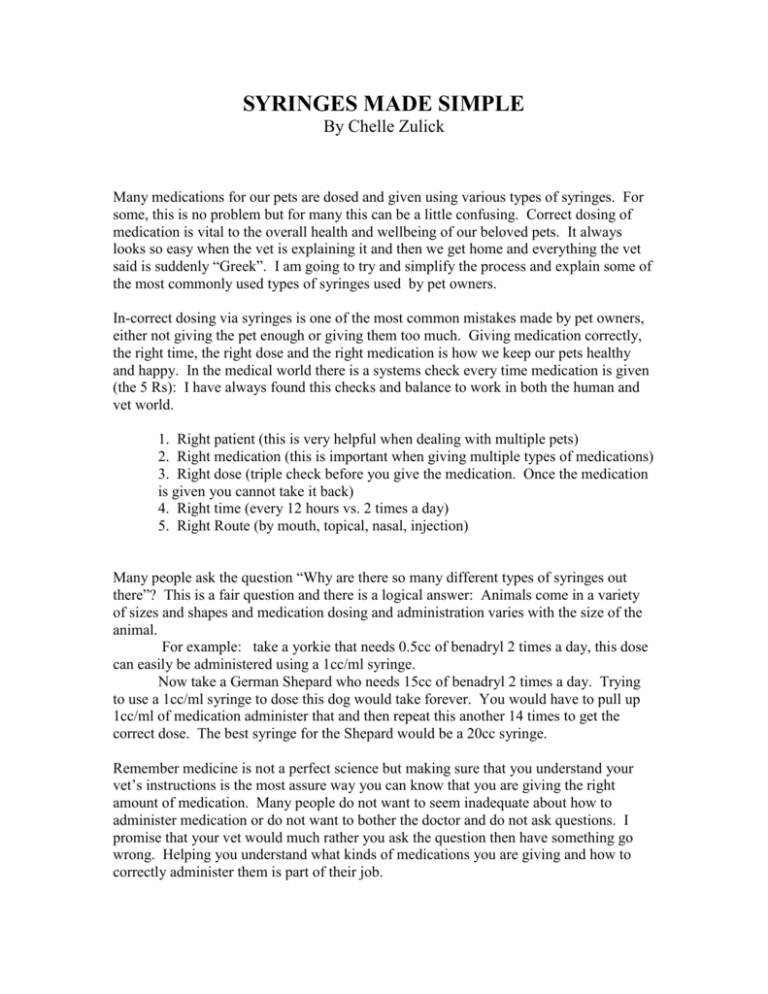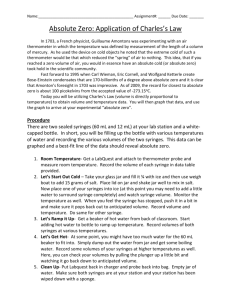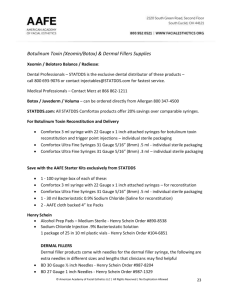SYRINGES MADE SIMPLE - Yorkie Angel Patrol
advertisement

SYRINGES MADE SIMPLE By Chelle Zulick Many medications for our pets are dosed and given using various types of syringes. For some, this is no problem but for many this can be a little confusing. Correct dosing of medication is vital to the overall health and wellbeing of our beloved pets. It always looks so easy when the vet is explaining it and then we get home and everything the vet said is suddenly “Greek”. I am going to try and simplify the process and explain some of the most commonly used types of syringes used by pet owners. In-correct dosing via syringes is one of the most common mistakes made by pet owners, either not giving the pet enough or giving them too much. Giving medication correctly, the right time, the right dose and the right medication is how we keep our pets healthy and happy. In the medical world there is a systems check every time medication is given (the 5 Rs): I have always found this checks and balance to work in both the human and vet world. 1. Right patient (this is very helpful when dealing with multiple pets) 2. Right medication (this is important when giving multiple types of medications) 3. Right dose (triple check before you give the medication. Once the medication is given you cannot take it back) 4. Right time (every 12 hours vs. 2 times a day) 5. Right Route (by mouth, topical, nasal, injection) Many people ask the question “Why are there so many different types of syringes out there”? This is a fair question and there is a logical answer: Animals come in a variety of sizes and shapes and medication dosing and administration varies with the size of the animal. For example: take a yorkie that needs 0.5cc of benadryl 2 times a day, this dose can easily be administered using a 1cc/ml syringe. Now take a German Shepard who needs 15cc of benadryl 2 times a day. Trying to use a 1cc/ml syringe to dose this dog would take forever. You would have to pull up 1cc/ml of medication administer that and then repeat this another 14 times to get the correct dose. The best syringe for the Shepard would be a 20cc syringe. Remember medicine is not a perfect science but making sure that you understand your vet’s instructions is the most assure way you can know that you are giving the right amount of medication. Many people do not want to seem inadequate about how to administer medication or do not want to bother the doctor and do not ask questions. I promise that your vet would much rather you ask the question then have something go wrong. Helping you understand what kinds of medications you are giving and how to correctly administer them is part of their job. 1. Insulin Syringes: These are one of the most commonly used syringes. They are usually used for insulin and can also be used for administering allergy medications. The needle is very small and share and penetrates the skin easily. This is a subcutaneous needle, meaning that is goes in just below the skin at a 45-60 degree angle. These syringes are intended to be used once and then should be placed in a sharp proof container and then returned to your vet for proper disposal. There are several types of insulin on the market and several types of insulin syringes. It is “VERY IMPORTANT” to make sure you are using the correct syringe with the correct insulin. Two of the most common insulin syringes are the U-40 and U-100. Insulin syringes are always in “Units”…NEVER IN ML or CC……..One should never use a cc/ml syringe to dose insulin. These doses are very different and can result in overdosing a pet. There are two types of insulin syringes: U-40 (for insulin of the 40 units per cc concentration) and U-100 syringes (for insulin of the 100 units per cc concentration). The type of syringes used must match the insulin used. Most human insulins (Lantus and Humulin) are 100 units per cc while most veterinary insulins (PZI and Vetsulin) are more dilute at 40 units per cc. Insulin syringes may be available through your veterinarian’s office or through your regular drugstore but do not be surprised if a prescription is needed from your drugstore. Insulin purchased at the drugstore may or may not require a prescription. Insulin is considered an over-the-counter medication for humans, but when it is used in pets, it is technically “off-label” so a prescription may be needed. Insulin syringes are made extra fine so that human diabetics will not feel them. Veterinary syringes are similarly fine and your pet should not object to injections. 2. 1cc Syringe: This is used most commonly in small breed animals. Each black mark on a 1cc syringe is 1/100 of a cc. Medication doses are generally small and these syringes are marked so that even a tiny dose of 0.1cc can be dosed correctly. EXAMPLE: Your vet prescribes 0.75ml of clavamox 2 times daily. You take the syringe and pull back to the 0.7 mark and then 5 more small black lines. This will put the plunger between the 7 and the 8. EXAMPLE: The vet prescribes 0.5ml of benadryl every 12 hours for 3 days. You pull the plunger back to the 0.5 mark and you have the correct dose. 3. 3cc, 5cc, 10cc, Syringes are also used for many animals. These are easy to use if you are dosing at least 1cc of medication. Any smaller dose would be very difficult to achieve the correct amount. 4. 20cc, 30cc, 40cc and 50cc are mostly used in larger breeds and rarely used in small breeds unless the syringe is used to irrigate a wound or flush something from the eyes. 5. Metacam is a drug that is often prescribed for inflammatory type pain, arthritis, sprains, etc. This medication is dosed using LBS (pounds). It is one of the few medications we give where administration is based on the weight of the animal in pounds. Metacam comes in a box with its own syringe. The syringe is labeled in pounds and Matacam is written across the syringe. This type of syringe is never to be used for anything else; it is very specific to this medication. This syringe has purple marks instead of black marks. Each mark is equal to 1 lb. I advise people to keep the Metacam box with the syringe in it so that it does not get mixed up with the others… EXAMPLE: Your vet prescribes Fluffy Metacam 1 time daily for 7 days for minor inflammation in the knee. Fluffy is a small 5 lbs Maltese. The syringe fits directly on top of the Metacam bottle for easy dispensing. You pull the plunger back to the 5 lbs purple mark on the bottle. This will be the correct dosing for Fluffy. Here are some basic conversions: 1lb = 2.2 kg CC=ML ¼ tsp = 1ml 1 tsp = 5ml 3 tsp = 1 Tablespoon 1 Tablespoon = 15ml Remember to always listen to the instructions from your veterinarian and if you have concerns or do not understand please ask the doctor to explain it again. Another way to make sure that you have correct understanding is to go through it once with the doctor. This will make sure that you can do it correctly and it is another way of double checking to make sure that the dose is correct. Doctors are human and mistakes can happen. It never hurts to ask.

